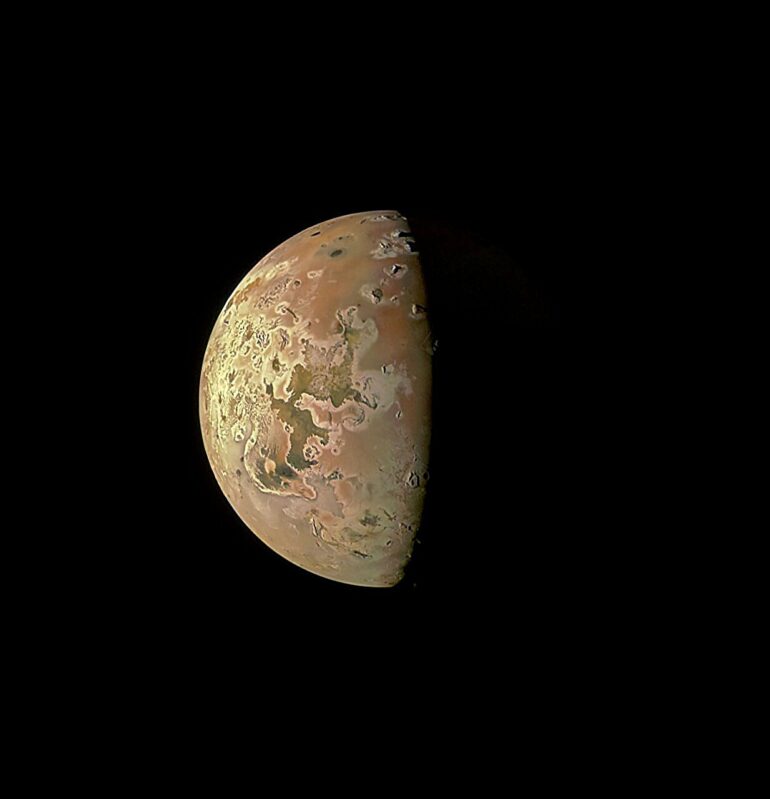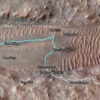By staring into the hellish landscape of Jupiter’s moon Io—the most volcanically active location in the solar system—Cornell astronomers have been able to study a fundamental process in planetary formation and evolution: tidal heating.
“Tidal heating plays an important role in the heating and orbital evolution of celestial bodies,” said Alex Hayes ’03, M.Eng. ’04, the Jennifer and Albert Sohn Professor of Astronomy in the College of Arts and Sciences. “It provides the warmth necessary to form and sustain subsurface oceans in the moons around giant planets like Jupiter and Saturn.”
“Studying the inhospitable landscape of Io’s volcanoes actually inspires science to look for life,” said lead author Madeline Pettine, a doctoral student in astronomy (Graduate School).
By examining flyby data from the NASA spacecraft Juno, the astronomers found that Io has active volcanoes at its poles that may help to regulate tidal heating—which causes friction—in its magma interior.
“I’m trying to match the pattern of volcanoes on Io and the heat flow that they’re producing with the heat flow we expected from theoretical models,” said Pettine, on the new research, “JIRAM Observations of Volcanic Flux on Io: Distribution and Comparison to Tidal Heat Flow Models,” published Sept. 7 in Geophysical Research Letters.
Pettine is advised by co-author Julie Rathbun ’99, senior research associate in the Department of Astronomy (A&S) and Hayes.
Jupiter has 95 moons and Io, which Galileo discovered through a telescope in 1610—roughly the same size as Earth’s moon—is a fiery, wild place. It orbits close to Jupiter and features about 400 active volcanoes.
“The gravity from Jupiter is incredibly strong,” Pettine said. “Considering the gravitational interactions with the large planet’s other moons, Io ends up getting bullied, constantly stretched and scrunched up. With that tidal deformation, it creates a lot of internal heat within the moon.”
Using a mathematical equation called spherical harmonic decomposition, a way of understanding round objects, Pettine broke down Juno’s flyby maps to establish complex volcanic surface patterns. Matching her work against theory, she found a surprising number of active volcanoes at Io’s poles, as opposed to the more-common equatorial regions.
“I’m not solving tidal heating with this one paper,” said Pettine. “However, if you think about icy moons in the outer solar system, other moons like Jupiter’s Europa, or Saturn’s Titan and Enceladus, they’re the places that if we’re going to find life in the solar system, it will be one of those places.”
The interior liquid water oceans in the icy moons may be kept liquefied by tidal heating, Pettine said.
“We need to know how the heat is being generated,” she said. “It’s easier to study tidal heating on a volcanic world rather than peering through a kilometers-thick ice shell that’s keeping the heat covered up.”
Pettine used the Jovian Infrared Auroral Mapper (JIRAM) imager from 11 flybys to scope out Io’s volcanoes. The scientists found that both pole regions had active volcanoes. In the north, a cluster of four volcanoes—Asis, Zal, Tonatiuh, one unnamed and an independent one named Loki—were highly active and persistent with a long history of space mission and ground-based observations. A southern group, the volcanoes Kanehekili, Uta and Laki-Oi demonstrated strong activity.
The long-lived quartet of northern volcanoes concurrently became bright and seemed to respond to one another. “They all got bright and then dim at a comparable pace,” Pettine said. “It’s interesting to see volcanoes and seeing how they respond to each other.”
In addition to Pettine, Rathbun and Hayes, co-authors on this paper are Samara Imbeah ’21; Rosaly M. C. Lopes, Jet Propulsion Laboratory and an adjunct professor of astronomy at Cornell; Shannon Bertolino, Cornell researcher; and A. Mura, F. Tosi, F. Zambon, of INAF-IAPS, Rome.
More information:
M. Pettine et al, JIRAM Observations of Volcanic Flux on Io: Distribution and Comparison to Tidal Heat Flow Models, Geophysical Research Letters (2024). DOI: 10.1029/2023GL105782
Provided by
Cornell University
Citation:
Volcanoes may help reveal interior heat on Jupiter moon (2024, September 19)



